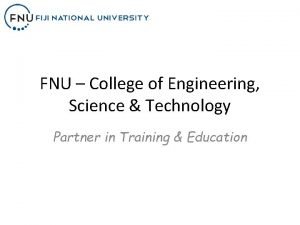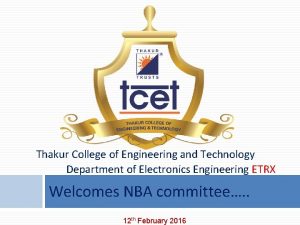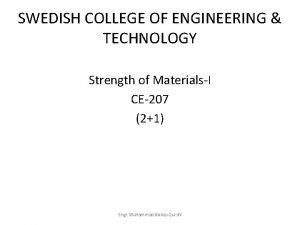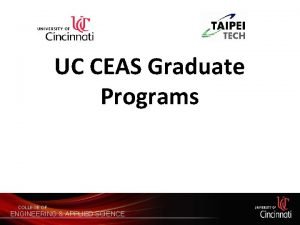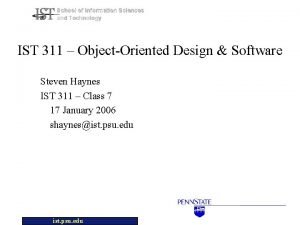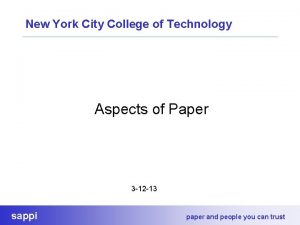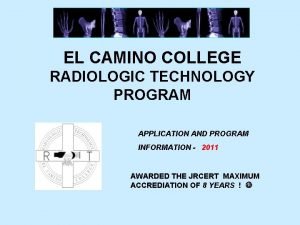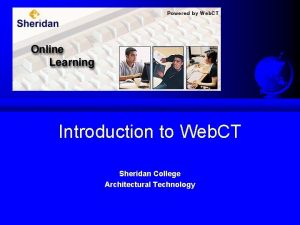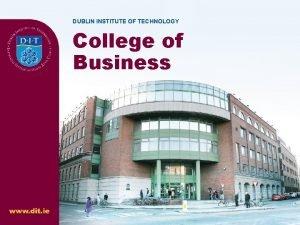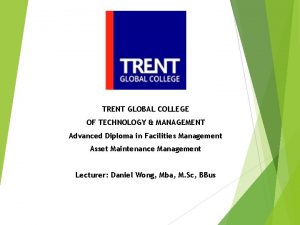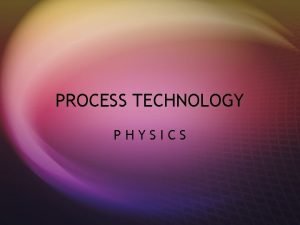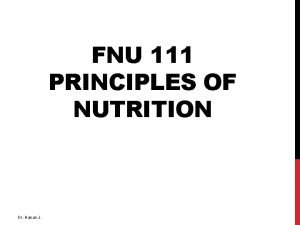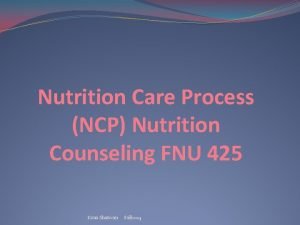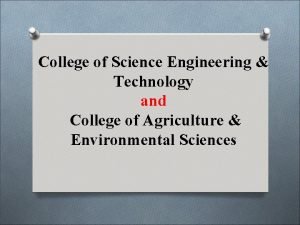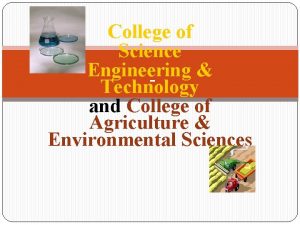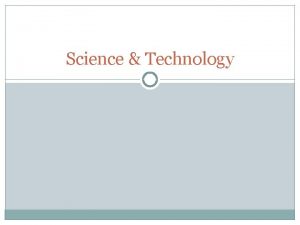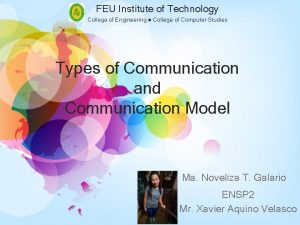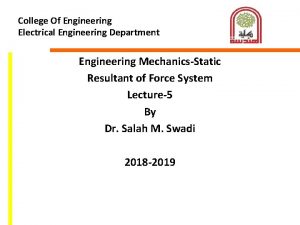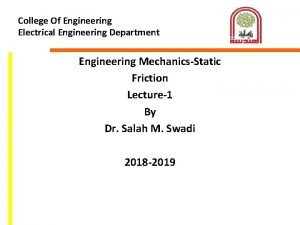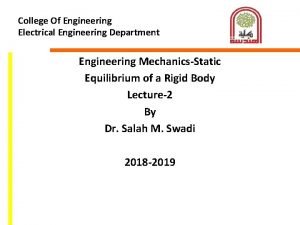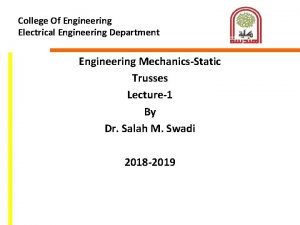FNU College of Engineering Science Technology Partner in
















- Slides: 16

FNU – College of Engineering, Science & Technology Partner in Training & Education

FNU Brief History • Established in 2010 • Merger of six government institutions – i) Fiji Institute of Technology; ii) Fiji School of Medicine; iii) Fiji School of Nursing; iv) Fiji College of Advanced Education; v) Lautoka Teachers College and vi) Fiji College of Agriculture And the Training and Productivity Authority of Fiji.

FNU – Overview • Five Colleges: i) College of Agriculture, Fisheries & Forestry ii) College of Business, Hospitality & Tourism Studies iii) College of Engineering, Science & Technology iv) College of Humanities & Education v) College of Medicine, Nursing and Health Sciences; And the National Training and Productivity Centre

FNU Background • A ‘dual sector’ university, offering technical and vocational education and training (TVET) and higher education, from certificates to doctorates. • Operate in about 30 campuses & locations in Fiji. • Total student number of about 30, 000 • Our focus “To provide education and training which is aimed at employability”

Some Characteristics TVET HE • Hands on or Job Specific Skills • Competency Based Training • Experience is important • Adaptive (creative) skills • Easier to get jobs • Education with learning (academic) • Research. Simulation & Analysis • Design & innovation • New knowledge • Not so easy to get jobs

WORKING RELATIONSHIP – FOR PROGRESS & DEVELOPMENT TVET HE PROGRESS & DEVELOPMENT IAC SCH “ALL PARTIES NEED EACH OTHER – RECOGNISING THE IMPORTANT PART THAT EACH PLAY”

Fiji Qualification Framework (FQF) • Basis of Quality Assured qualifications in Fiji • Defines the QA for HE Institutions and qualifications provided in Fiji. • These quality standards form the basis of Fiji Higher Education Commission’s (FHEC) legislative powers.

FQF Summary 8 7 6 5 4 3 2 1 MASTERS PGD UNDERGRADUATE DIPLOMA CERTIFICATES PHD HIGHER EDUCATION CLASSIFICATION TVET 10 9 POST GRADUATE QUALIFICATIONS (AWARDS) DEGREES LEVELS

PROGRAMME STRUCTURE CERTIFICATE 3 CERTIFICATE 4 DIPLOMAS DEGREES CREDIT POINTS 90 120 360 480 HOURS OF LEARNING 900 1200 3600 4800

Modes of Delivery Relevant Work Experience Contact Hours Cert 3 Quarter 1 Cert 4 Quarter 2 Common Units Quarter 1 Quarter 2 1 Quarter = 8 weeks contact of 6 units @ 5 CP each (total of 30 CP per Quarter) = 0. 5 semester Quarter 3 6 months Quarter 3 Quarter 4 12* months Specialisation/Licensing = 2 Quarters *6 months if already done 6 months for Cert 3

CEST Diploma/Bachelors Programme Structure Programme Levels Total Credit Points Duration Units/Semester Diploma 6 360 3 years (6 semesters) 5 units (@12 CPs each) Bachelors (Honours) 8 480 4 years (8 semesters) 4 units (@ 15 CPs each)

CEST Programme Articulation Diploma (level 6) Year 3 Year 2 Year 1 Minimum Entry Requirement Pass in FSLC (year 12 exams) with pass in English, Maths & Physics Articulation /Pathway At the completion of year 3 Diploma can enter Year 3 of the BEng(Honours). Some units of Maths & Science maybe required as bridging units. Bachelor of Engineering (Honours) Year 4 Year 3 Year 2 Year 1 Pass in year 13 or Form 7 exams with pass in English, Maths & Physics and total aggregate of 280

Pathways Mapping Year 11 Enter to Pass Cert 2 (TCF) (b) Year 12 Enter to (b) Year 13 Enter to Pass (a) Diploma Certificate (with 3 Eng; Phy & Maths) Cert 4 (a) Pass with 280 (a)BE Honours Or BEng + Bridging (Eng+Maths+ Phy+1 Tech) Fail Certificate Pass (c) Certificate (b) Less (200/400) 4 2 than 280 (TCF) (b) Diploma (c) Cert 4 Fail (d) Certificate 3 (c) Fail

Alternate Pathways & Duration Options A (HE) Pathways (post form 6) Pass in Year 12 + Year 13 Pass with 280 marks + BEng Hons Total Duration Awards 5 years 1 BEng (Hons) B (TVET) Year 12 Pass in 5 years Eng/Maths/Physics + Diploma + BEng Hons 2 Dip + BEng (Hons)

Conclusions • Dual sector advantage = articulation between the TVET & HE; • TVET & HE articulation provide students pathways to progress; • TVET provides the alternate pathway which staircase into the HE • TVET Training is critical for National Development

Q & A Thank You & Vinaka vakalevu! CONTACT: salabogi. mavoa@fnu. ac. fj or adeng@fnu. ac. fj Acting Dean College of Engineering, Science & Technology Derrick Campus, Suva. (679) 8329876 or 7130598
 Fnu engineering courses
Fnu engineering courses Thakur college of engineering and technology
Thakur college of engineering and technology Parasitic food chain
Parasitic food chain Swedish college of engineering and technology
Swedish college of engineering and technology Ucf software engineering
Ucf software engineering Uc ceas
Uc ceas Science fusion think central
Science fusion think central What's your favourite subject at school
What's your favourite subject at school Travel technology partner
Travel technology partner College of information sciences and technology
College of information sciences and technology How many colors do you see
How many colors do you see Nara national college of technology
Nara national college of technology El camino radiology
El camino radiology Sheridan college architectural technology
Sheridan college architectural technology Dublin institute of technology college of business
Dublin institute of technology college of business Trent global college review
Trent global college review Ptec degree salary
Ptec degree salary
